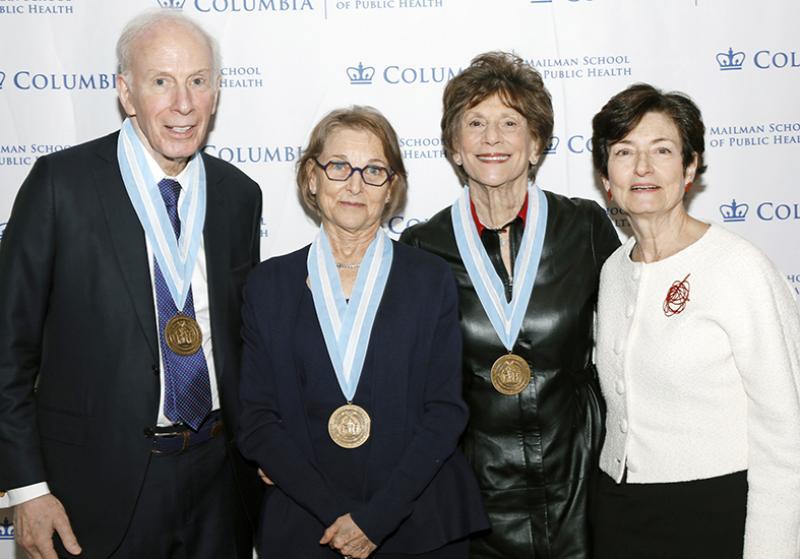Virginia Rauh Installed as the Jane and Alan Batkin Professor in Child Health and Well-Being

Columbia University and its Mailman School of Public Health recently celebrated the appointment of Virginia Rauh as the inaugural Jane and Alan Batkin Professor in Child Health and Well-Being. The endowed professorship was made possible by the generosity of long-time children’s health advocates Alan Batkin, chair emeritus of Columbia Mailman’s Board of Advisors, and his wife Jane Batkin, a child psychologist.
“To my mind, Jane and Alan Batkin set an example of how individuals can make a profound impact on the future. Their extraordinary generosity ensures that we will be able to continue to invest in children’s health,” said Dean Linda P. Fried, as she kicked off a presentation of medals to Rauh and the Batkins.
Rauh, who is director of the new Child Health Center for Learning and Development, discussed pivotal people and moments in her career, including her time as a psychiatric social worker in the neonatal intensive care unit (NICU) at a Vermont hospital. There, she got her first glimpse of how the growth and development of babies and even preemies can be affected by their environment and the people they come into contact with, something that would become a life-long passion. “Back then, in the ’70s, it wasn’t as common for mothers and fathers to be invited into the NICU,” she recalled. “What I saw there and what later became the subject of my doctoral dissertation, was that parents who didn’t get to know their tiny babies often went home afraid to care for them, and interacted with them less. That was problematic.” Those observations about early exposures stayed with her when she came to Columbia in 1984 and began working with Frederica Perera, founding director of the Columbia Center for Children’s Environmental Health. “We were looking at the effects of toxic exposures on children, but we used the same principles as Rudder, following a group of children prospectively,” says Rauh, who is known for her groundbreaking research on the effects of chlorpyrifos, an insecticide that was first developed in Germany in the 1930s to be used as a nerve gas during wartime. For decades, it was (and still is) widely used as a pesticide. “One of our colleagues, [professor emeritus] Robin Wyhatt, was prescient enough to want to measure the effects of pesticide exposure so we looked at the levels of this organic phosphate in umbilical cord blood,” recounted Rauh. “That was unusual because most exposures are just estimates, but we were able to get more precise measures.” The team’s findings—that the chemical could cause irreversible brain damage, especially in young children—helped lead to a partial ban of its use in 2021. “It was one of the huge successes of the Center,” Rauh noted.
Those successes will no doubt be followed by others, in part thanks to the endowed chair made possible by Alan and Jane Batkin. After brief remarks by Dean Fried; Katrina Armstrong, CEO of Columbia University Irving Medical Center, Patrick Kachur, interim chair of the Heilbrunn Department of Population and Family Health, and Dina Dublon, Chair of Columbia Mailman’s Board of Advisors, Alan and Jane Batkin stepped up to the podium to reiterate their support for the well-being of children around the world—and for the field of public health. “So many millions of kids die of treatable diseases every year. This shouldn’t be happening,” Batkin told the audience of Mailman professors and staff, along with friends and family of the Batkins and Rauh. “That’s why we’re thrilled that Ginny Rauh is heading up the new [Child Health Center for Learning and Development] and is the first person in the professorship.”
As she stepped up to the podium sporting her new medal, Rauh was clearly thrilled as well. “It’s awesome to think about where we’ll go from here, with the generosity of the Batkins,” she said. “But what I know is that we’ll all be working together to raise the bar further for our students, faculty, and staff.”
Editor’s note: A version of this article was originally published by Columbia University Mailman School of Public Health.
Support Columbia Mailman
